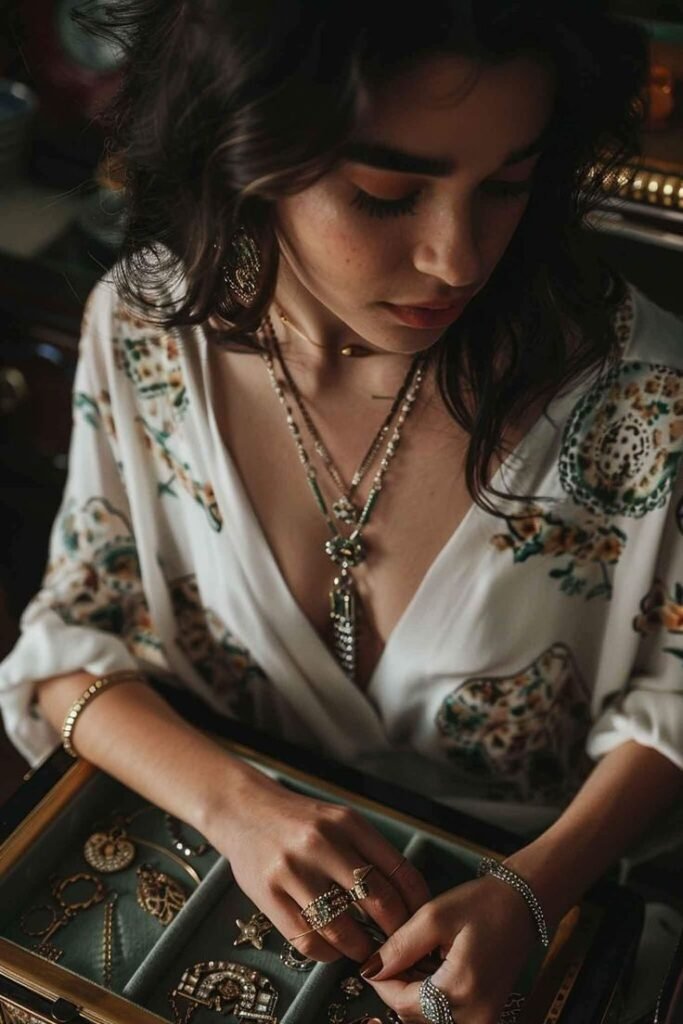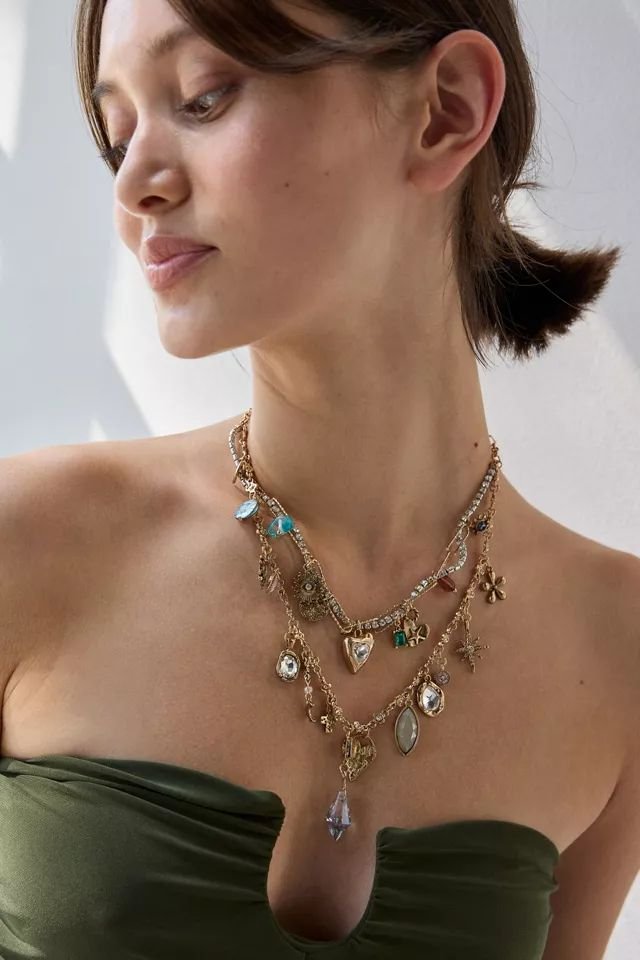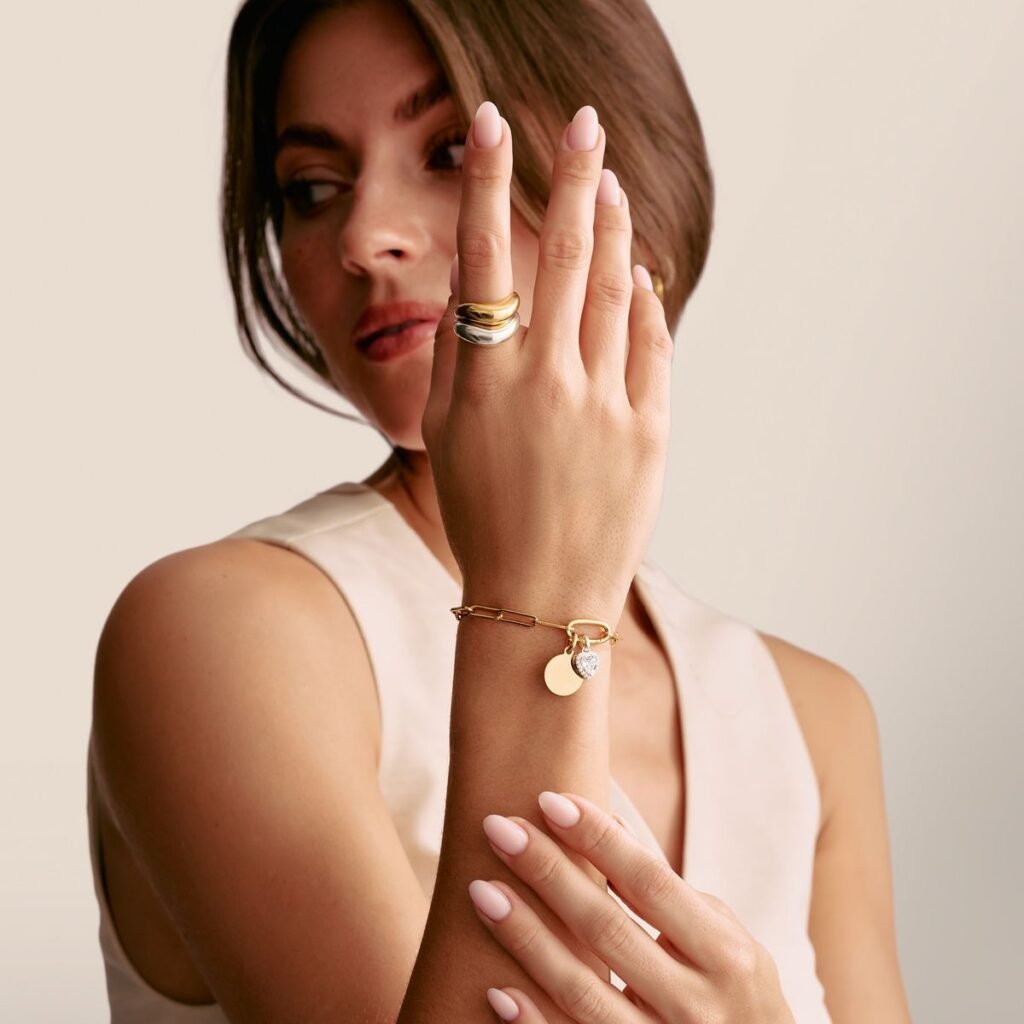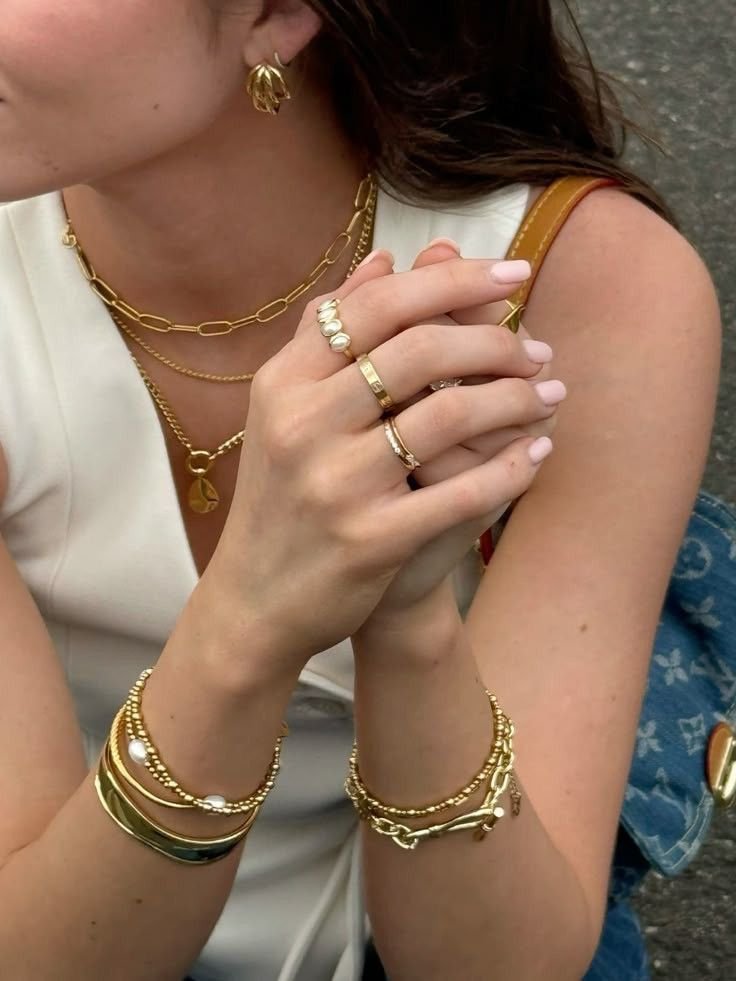Introduction
Accessories are the finishing touches that can transform any outfit from ordinary to extraordinary. However, many people struggle with how to accessorize daily outfits without overdoing it. Wearing too many pieces or mismatched items can make an ensemble look chaotic, while neglecting entirely may leave your look feeling incomplete.
The goal is balance. Enhance your outfit, highlight your personal style, and provide functional benefits without overwhelming your overall appearance. From delicate jewelry and scarves to belts, hats, and bags, each piece contributes to your daily look in a unique way.
Mastering the art of accessorizing is not just about following trends; it’s about making intentional choices that complement your clothing, occasion, and personality. The right can add color, texture, and sophistication, making even the simplest outfit feel polished and thoughtful.
This guide explores practical strategies to accessorize daily outfits effectively. You will learn how to choose, layer, and match , avoid common mistakes, and build a versatile collection. By the end, you’ll have the tools to confidently elevate your style every day, creating outfits that are chic, balanced, and reflective of your personal aesthetic.
Accessories have the power to transform any outfit, elevating even the simplest ensemble into a polished and stylish look. However, many people struggle with how to accessorize daily outfits without overdoing it. Wearing too many pieces or choosing items that clash can make an outfit look chaotic rather than chic. On the other hand, avoiding altogether can make your look feel incomplete or dull.
The key is finding balance — choosing the right for your outfit, occasion, and personal style. Accessories don’t just enhance style; they reflect personality and attention to detail. They can add color, texture, and sophistication to an outfit and can be functional too, such as belts, scarves, or watches.
This guide explores practical strategies for accessorizing daily outfits thoughtfully. You’ll learn how to choose that complement your look, mix and match effectively, and avoid common mistakes. Whether you’re dressing for work, casual outings, or social events, these tips will help you elevate your style effortlessly while maintaining harmony in your outfits. By the end, you’ll feel confident in your ability to accessorize daily outfits with taste, sophistication, and creativity, without overwhelming your overall look.
1. Understanding the Role of Accessories
Accessories are more than just decorative items; they play a crucial role in completing and elevating any outfit. They can enhance style, add personality, and even provide practical benefits. For example, a simple dress can become stylish and eye-catching with the addition of a statement necklace or a colorful scarf. Similarly, a sleek watch or belt can define your silhouette and add structure to your look.
Beyond aesthetics, serve as a form of personal expression. Jewelry, hats, and bags reflect your taste, mood, and lifestyle. Delicate pieces convey elegance, while bold, chunky items can signal confidence and creativity. Choosing thoughtfully allows you to showcase your personality through your daily outfits.
Accessories also have functional purposes. Belts can cinch the waist, scarves can provide warmth or coverage, and hats protect from sun or rain. Understanding the purpose and impact of each accessory helps prevent over-accessorizing, ensuring that every item contributes positively to your overall look.
By recognizing the different roles play—style enhancement, personal expression, and functionality—you can make intentional choices that complement your outfits. This thoughtful approach ensures your ensembles are balanced, polished, and visually appealing without feeling cluttered.
Accessories are not merely decorative; they play several key roles in fashion. Firstly, they enhance style by adding interest, texture, or color contrast. A neutral outfit can be brought to life with a statement necklace, a vibrant scarf, or bold shoes.
Secondly, allow for personal expression. Watches, bracelets, and rings can reflect your personality or mood. Subtle choices like delicate earrings can convey elegance, while chunky pieces may communicate boldness and confidence.
Accessories also serve functional purposes. Belts help define silhouettes, hats provide sun protection, and bags offer practicality. Properly selected ensure both style and function coexist seamlessly.
Understanding the purpose of each accessory helps avoid over-accessorizing. Instead of randomly layering items, think about which pieces enhance your outfit and why. This strategic approach ensures complement rather than compete with your clothing.
Finally, understanding accessory categories — jewelry, bags, scarves, hats, belts, shoes, and eyewear — is crucial. Recognizing how each category contributes to a look will make mixing and matching intuitive, helping you elevate your style without cluttering your ensemble.

2. Choosing Accessories That Match Your Outfit
Choosing the right is key to creating a cohesive and stylish look. Start by considering your outfit’s color palette, patterns, and textures. For example, a neutral outfit can handle bold, colorful , while a patterned or brightly colored outfit benefits from subtle, understated pieces. Matching or complementing colors creates harmony and prevents your outfit from looking chaotic.
Metal tones are another important factor. Avoid mixing too many metals — stick to silver, gold, or rose gold for a polished appearance. Coordinated metals across your jewelry and hardware, such as bag clasps or belt buckles, create a unified and sophisticated look.
Consider the scale and size of . Large statement pieces work best with simple outfits, while delicate, minimalist items pair well with busy patterns or intricate designs. This ensures that your enhance, rather than overpower, your clothing.
Finally, take the occasion and setting into account. Work or professional settings often call for minimal, elegant , while casual outings allow for more playful or colorful choices. Seasonal considerations also matter: lighter, brighter pieces suit summer outfits, while textured or layered work well in fall and winter.
By thoughtfully matching accessories to your outfit, you ensure balance, style, and confidence in your daily looks.
The first step in accessorizing daily outfits is selecting items that harmonize with your clothing. Consider the color scheme, pattern, and texture of your outfit. For example, a printed dress pairs best with subtle , while a monochrome outfit allows bolder statements.
Metal tones should also coordinate. Avoid mixing silver, gold, and rose gold excessively unless deliberately going for a layered, eclectic look. Matching metals in your jewelry creates a cohesive appearance.
The scale of matters as well. Large statement pieces work better with simple outfits, while delicate suit more intricate clothing patterns. Balance is key: if your top is highly detailed, keep jewelry minimal, and vice versa.
Additionally, consider the occasion. Work outfits may require understated, professional pieces, while casual outings or parties can accommodate playful, colorful . Seasonal choices can influence selection too — light fabrics in summer pair well with minimal, bright , whereas heavier fall and winter clothing often suit layered and textured items.
By thoughtfully choosing that complement the outfit’s color, style, and context, you create a polished, cohesive look without risking over-accessorizing.
3. Layering Accessories Without Overcrowding
Layering can add depth, interest, and personality to your outfits, but it requires careful balance to avoid looking cluttered. The key is strategic layering — combining pieces that complement each other in style, color, and size. Start with a focal piece, such as a statement necklace or bold bracelet, and then add smaller, supporting items that enhance without competing for attention.
Pay attention to proportion and scale. For example, chunky necklaces pair well with simple clothing, while delicate chains work better with patterned or textured outfits. Similarly, stacking bracelets or rings can be stylish, but avoid combining too many large pieces at once, as it can overwhelm the look.
Consider texture and material when layering. Mixing metals, beads, leather, or fabric adds visual interest, but stick to two or three complementary materials to maintain harmony.
Finally, balance your overall look by spreading layers across different areas. If you wear layered necklaces, keep earrings minimal. If bracelets are stacked, avoid adding large rings on every finger. Thoughtful layering ensures your enhance your outfit, showcase creativity, and add sophistication without overcrowding your overall style.
Layering can add depth and dimension, but it’s easy to overdo it. The key is strategic layering. Start with one focal piece, such as a necklace, and add supporting elements like bracelets or rings in moderation.
For example, wearing a statement necklace with matching small earrings works better than adding oversized rings or bangles that compete visually. Similarly, layering thin necklaces of varying lengths can create elegance without clutter.
Consider textures and materials. Mixing metals, leather, beads, or fabric can add interest, but do so thoughtfully. Stick to two or three textures to avoid overwhelming the outfit.
Balance your body proportions. Taller individuals can wear longer necklaces or stacked bracelets; petite figures often benefit from delicate, minimal pieces. Avoid letting overshadow your overall silhouette.
Finally, use repetition and symmetry. Repeating a color, shape, or style across creates harmony. Symmetry in earrings, bracelets, or rings keeps the look intentional rather than chaotic.
Thoughtful layering enhances your outfit, adds personality, and showcases creativity while preventing over-accessorizing.

4. Statement Pieces vs. Minimal Accessories
Understanding the difference between statement and minimal is key to creating balanced and stylish outfits. Statement pieces are bold, eye-catching items, such as chunky necklaces, large earrings, or patterned scarves. They draw attention and can define an outfit, making a simple look feel polished and memorable. Statement work best with neutral or minimal clothing, allowing the accessory to stand out without clashing.
On the other hand, minimal are subtle, delicate pieces that complement your outfit without overpowering it. Think thin chains, small studs, or simple bracelets. These pieces add elegance and sophistication, especially when paired with patterned, textured, or colorful clothing. Minimal are ideal for professional settings, formal events, or daily casual wear where understated elegance is preferred.
A helpful strategy is the “one statement rule”: choose one bold item and pair it with minimal supporting pieces. For example, wear a chunky necklace with small earrings or a statement bracelet with delicate rings. This ensures your outfit remains harmonious and visually appealing.
By balancing statement and minimal thoughtfully, you can elevate any outfit, express personal style, and avoid the risk of over-accessorizing.
Choosing between statement and minimal depends on your outfit and desired impact. Statement pieces — bold necklaces, large earrings, or patterned scarves — draw attention and can define a look. They work best with simple, neutral clothing where the accessory becomes the focal point.
Minimal accessories, such as delicate jewelry or understated watches, create elegance and complement detailed or colorful clothing without overwhelming it. They are ideal for professional settings, formal occasions, or everyday wear.
A useful rule is the “one statement rule”: pick one standout item and keep others subtle. For instance, a chunky bracelet can be paired with a simple necklace, or bold earrings with an unadorned neckline. This prevents clutter and ensures your outfit looks curated.
Mixing statement and minimal pieces strategically allows flexibility. A bright scarf can be paired with understated jewelry, while a statement necklace works with neutral shoes and bag. Recognizing the visual weight of each accessory helps maintain balance and sophistication.
5. Matching Accessories to Your Personal Style
Your personal style should guide every accessory choice, ensuring your outfits feel natural and authentic. Start by identifying your style: classic, bohemian, edgy, or minimalist. Each style has specific accessories that enhance your overall look.
Personal style dictates accessory choices. Identify whether your style is classic, bohemian, edgy, or minimalist, and select accessories that reinforce it.
- Classic style: Pearl earrings, leather handbags, simple watches.
- Bohemian style: Layered bracelets, beaded necklaces, fringe bags.
- Edgy style: Chunky chains, leather belts, bold sunglasses.
- Minimalist style: Delicate rings, thin chains, monochrome bags.
Staying true to your style ensures accessories feel natural rather than forced. Even when experimenting with trends, incorporate them subtly to avoid clashing with your core aesthetic.
Personal style also guides color and material choices. A neutral wardrobe may accommodate colorful accessories, while a vibrant wardrobe may benefit from muted accents. Accessories should enhance, not overpower, your signature look.
6. Accessories for Different Occasions
The key to daily accessorizing is adapting your choices to the occasion. Accessories that work for casual outings may not be suitable for work or formal events, and knowing the difference ensures your look is always appropriate.
For work or professional settings, choose subtle and elegant pieces. Simple stud earrings, classic watches, and structured handbags create a polished appearance without being distracting. Minimalist jewelry and neutral-toned accessories maintain a professional tone while still adding style.
For casual outings, feel free to experiment with color and texture. Fun earrings, patterned scarves, or statement shoes can elevate a relaxed outfit. Layered bracelets or casual bags allow for creativity while keeping your look balanced.
During formal events, prioritize sophistication and refinement. Statement necklaces, elegant clutches, and polished shoes can transform a simple dress into a standout ensemble. Keep your accessories cohesive and avoid mixing too many bold pieces at once.
For travel or busy days, functional accessories like crossbody bags, scarves that double as wraps, and watches combine practicality with style.
By considering the occasion, you can choose accessories that enhance your outfit, stay appropriate, and avoid over-accessorizing, ensuring your look is always intentional and stylish.
Daily accessorizing changes based on context:
- Work: Subtle jewelry, structured handbags, professional shoes.
- Casual outings: Fun earrings, colorful scarves, versatile sneakers.
- Formal events: Statement jewelry, elegant clutches, polished shoes.
- Travel: Functional accessories like crossbody bags, watches, or scarves that double as wraps.
Adapting accessories to occasions ensures your outfit is appropriate, practical, and stylish without excess.

7. Practical Tips to Avoid Over-Accessorizing
- Follow the Rule of Three: Limit yourself to three main accessory points (neck, wrists, ears).
- Neutralize Busy Outfits: Pair patterned clothing with simple accessories.
- Keep a Signature Piece: A go-to accessory reduces decision fatigue.
- Mix Textures, Not Quantity: Two or three well-chosen materials look sophisticated.
- Step Back: View your outfit in a mirror before leaving to check balance.
8. Caring for and Organizing Accessories
Proper storage prevents damage and makes daily selection easier. Use jewelry boxes, trays, or hooks for necklaces, rings, and bracelets. Scarves and belts can be hung or folded neatly. Keeping accessories organized reduces clutter and ensures you reach for the right items quickly, avoiding overloading outfits.
9. Seasonal and Trend Considerations
Adapting accessories for seasons enhances your outfits. Summer favors lightweight fabrics, colorful jewelry, and straw hats. Fall and winter allow layering, textured scarves, and leather accessories. Trends can be incorporated subtly — e.g., a trendy belt or bag — without overwhelming your style. Seasonal awareness ensures your accessorizing remains fresh and balanced.
10. Building a Versatile Accessory Collection
Invest in timeless, versatile pieces that can be mixed and matched:
- Neutral-toned bags and shoes
- Simple gold or silver jewelry
- Scarves in classic patterns
- Belts in black and brown
A curated collection allows effortless accessorizing without the temptation to over-layer or clash styles.
Conclusion
Accessorizing daily outfits without overdoing it is about balance, intention, and personal style. Understanding the role of accessories, choosing complementary pieces, and following simple rules like the “one statement rule” ensures your outfits remain polished and harmonious. Layer thoughtfully, consider occasions, and adapt to seasons while staying true to your personal aesthetic.
With practice, accessorizing becomes intuitive, adding flair, functionality, and personality to your daily looks. By building a versatile collection and organizing it effectively, you can effortlessly elevate every outfit, making accessorizing a joyful and stress-free part of your daily routine.
Related Post: 7 Top Causes of Google Maps Not Working and How to Fix Them

